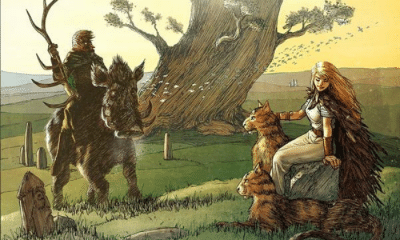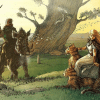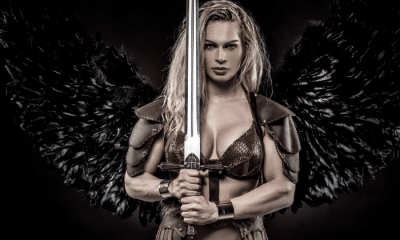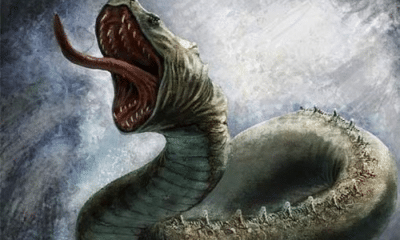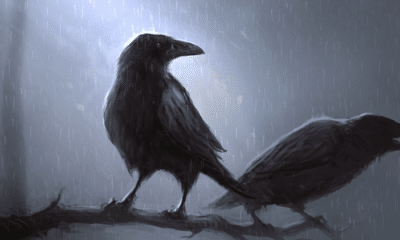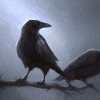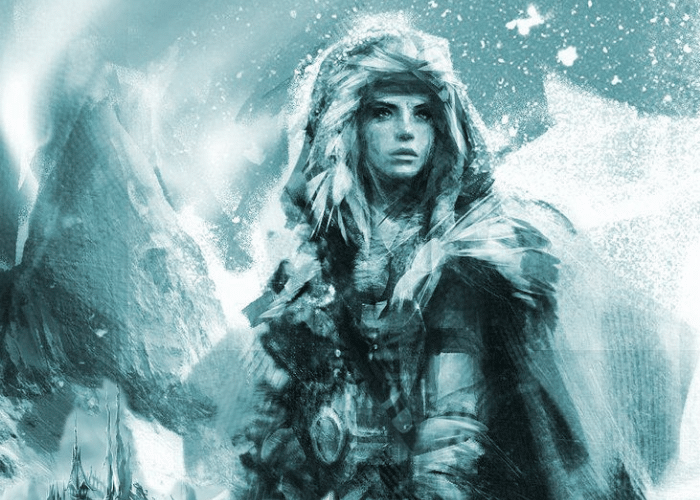
Norse
Who Was the Giantess Skadi?
Who Was the Giantess Skadi?
You may not know the name Skadi, but you know the land that she shares her name with. Keep reading to learn all about the giantess who may have given Scandinavia its name!
Skadi, spelled Skaði, was not truly one of the goddesses of the Norse pantheon. She was given a place among them, but she was actually a giantess.
Despite this, she features in many stories of the Aesir and Vanir gods. She attended their feasts, helped to punish their enemies, and famously married one of their most senior members.
She is often linked to the climate and geography of the Norse world. She made her home in the frigid mountains and was said to love hunting, skiing, archery, and other rugged activities.
The Norse may have centered their culture on the sea, but Skadi’s life in the mountains was also an important part of their society. This was recognized in the many places named for the giantess including, possibly, the entire region of Scandinavia.
Skadi may not have been born among the gods, but she held an important place in their pantheon. Some of Norse mythology’s most famous tales include the giantess who married into the family of the gods.
Skadi the Jötunn
In modern writings, Skadi is often described as a giantess. The word “giant” is often used as an interpretation of the Norse word jötunn.
The jötnar were not, however, giants as we often think of them today. Although they were not proper gods, they seem to have been closely related.
Some of the jötnar were enemies of the gods, such as the giants from the lands of ice and fire who would invade at Ragnarök, but others were on better terms. Many gods, including Odin, were said to have jötnar parents.
So while Skadi is usually called a giantess, descriptions of her do not fit the image modern readers may have when picturing a giant. She was described as “a fair maiden,” and “the shining bride of the gods.”
While Skadi may have been seen positively in Norse mythology, her father was less well-regarded.
Thiazi, written as Þjazi in Norse, more closely fit the stereotype of a giant.
He lived in a hall called Thrynheim, or Þrynheimr, in the world of Jötunheim’s rugged mountains. He was described as wealthy and powerful, but also greedy and cruel.
Thiazi was a giant who was not a friend to the gods. Because of this, he would play a major role in the mythology of his daughter and the gods of both Asgard and Vanaheim.
The Death of Her Father
The Prose Edda tells the full story of how Thiazi and Skadi came to be involved with the gods.
Odin, Loki, and Hoenir were traveling through the wilderness and found a herd of oxen. Needing food, they slaughtered one of the animals and attempted to roast it in an earthen oven.
No matter what they tried, however, the gods could not get the oven to light. Thiazi, in the form of a giant eagle, perched on an oak tree above them and claimed responsibility for the lack of fire.
He said that he would light the fire if the gods would allow him to share their meal. They agreed, but Loki grew angry when the eagle began devouring a majority of the cooked meat.
He tried to hit the eagle with his staff, but when the weapon hit the bird’s body it was magically stuck to him. Thiazi flew away, carrying Loki through the sky with him.
Thiazi flew low enough that branches and stones hit Loki as they went by. He agreed to release Loki only on the condition that Iðunn, the goddess of youth, be brought to him.
Loki agreed, although he knew the gods would never allow Iðunn to be taken to Jötenheim. He tricked the goddess into leaving with him and kidnapped her without anyone else seeing.
The Aesir soon learned, however, that she was gone. Thor threatened to torture Loki to death unless he returned to Thiazi’s home and brought the missing goddess back.
Loki transformed into a falcon and flew to Jötenheim. Finding Iðunn unguarded, he transformed her into a nut and flew away with her.
Thiazi saw this, however, and gave chase as a eagle. The two raced back toward Asgard and Thiazi began catching up to Loki’s smaller form.
The gods were watching for Loki’s arrival however, so they saw that Thiazi was about to catch up to the trickster and retake Iðunn. They saw no choice but to stop him, so they threw up a wall of fire just behind Loki as he approached Asgard.
Thiazi hit the fire and his wings were burned away. Some accounts said that he was killed when he fell, but most said that the gods attacked him on the ground and finished him off.
The jötunn was no longer a threat, but his daughter soon learned about how the Aesir had killed her father. Skadi put on a helmet and coat of mail, gathering her weapons and setting out for Asgard.
Skadi dressed for war to demand repayment from the gods, but the form that payment took was far more peaceful.
Skadi and Njord’s Unhappy Marriage
Skadi made two demands of the gods when she arrived in Asgard.
One of these was that they accomplish something that had been impossible since her father’s death. Skadi demanded that the gods make her laugh.
Loki obliged, humiliating himself to bring a smile to Skadi’s face. He tied a goat to himself by its beard so both he and the animal squealed loudly as they pulled one another back and forth.
When Loki collapsed into her lap, Skadi finally laughed.
Odin further pacified the angry jötunn maiden by placing her father’s eyes in the sky as stars. Skadi was pleased that Thiazi would be remembered, but she had one more demand for the gods.
Skadi demanded that she be allowed to marry one of the gods so that the loneliness she had felt since her father’s death would end.
Odin agreed to this, but on the condition that Skadi not be permitted to choose a husband outright. Instead, the gods would stand behind a curtain and she would have to choose a groom by seeing nothing but his feet.
Skadi was hoping to marry Baldr, the most handsome and well-loved of the Aesir, so she chose the most flawless feet before her. Instead of Baldr, however, they belonged to another god.
Njord, written as Njörðr in Old Norse, was the Vanir god of the sea. The two were married, but almost immediately disagreed.
After the wedding feast, Skadi wanted to return to Thrynheim and the mountains. Njord, however, made his home by the sea in Nóatún.
The new couple compromised and agreed to split the time between their homes. They first went to Thrynheim for nine nights.
Njord, however, was miserable in the mountains. He hated the sound of the howling wolves and was eager to return to the coast.
When they went to Nóatún, however, Skadi was just as unhappy. The noise of the seagulls kept her awake the entire time she was there.
Njord and Skadi were so unhappy together that they largely ended their compromise.
Thrymheim it is called
Where Thjasse dwelt,
That mightiest giant.
But now dwells Skade,
Pure bride of the gods,
In her father’s old homestead.
-Snorri Sturluson, Prose Edda (trans Anderson)
The jötunn and the god were so mismatched that they lived apart most of the time. Skadi, it was said, spent her days skiing and hunting in the mountains while Njord remained by the sea.
Possible Children
According to most sources, however, Skadi and Njord remained married. They often attended the gods’ feasts together and Skadi came to be regarded as a goddess in equal standing to others like Frigg or Sif.
It’s also implied that Skadi had children who were held in high regard. These were:
- Freyr – Njord’s son was associated with kingship and prosperity. He was among the most highly-regarded gods and joined his father as one of the Vanir who moved to Asgard.
- Freyja – Freyr’s sister is usually considered to be the goddess of love and beauty. She was also a warrior goddess who took half of the soldiers lost in battle to her hall to join Odin’s warriors of Valhalla in Ragnarök.
- Saemingr – One saga claimed that Skadi did not remain married to Njord and instead gave birth to a king of Norway who was fathered by Odin.
Skadi is never specifically named as Freyr and Freyja’s mother, although she is their father’s wife. Some accounts claim that Freyr joined the Aesir at the same time as his father, meaning that he was born before Njord and Skadi were married.
In the Poetic Edda, however, Skadi acts more maternally toward Freyr than might be expected if she were not his mother.
When the god spotted a jötunn maiden named Gerðr, he fell instantly in love. Freyr began to act so depressed that his longtime servant, Skírnir, is sent to find out what was wrong.
In most texts of the Poetic Edda, Njord alone commands Skírnir to discover the source of Freyr’s depression. In others, however, Skadi and Njord ask this together.
Most historians follow Snorri Sturluson’s text and change Skadi’s name to Njord’s in the line in which she is mentioned. Others, however, point to the pronouns used in the poem to prove that Skadi is involved as well.
When the servant is asked to question Freyr, the poem says “our son” instead of “my son.” Those who believe that Skadi should be included point to this as proof that two people originally asked after Freyr’s wellbeing.
This is scant evidence for a family relationship, but it is one of the most significant clues that exist regarding Skadi’s relationship with Freyr. According to one line of dialogue from the Poetic Edda, it may be possible that Skadi is the otherwise unidentified mother of Freyr and Freya.
Skadi’s Revenge
Skadi’s most significant relationship to another character in mythology, however, was not with Freyr. It was not even with her husband, Njord.
Skadi is very often linked closely to Loki. They were so intertwined that she played an important role in his eventual imprisonment and, as a result, the beginning of Ragnarök.
Loki often antagonized the gods but found a way to redeem himself in their eyes. When he cut off Sif’s hair, for example, he brought back not only a golden replacement but many other magical gifts for the gods as well.
Over time, however, Loki’s tricks became more cruel and destructive. He was more often in conflict with the gods than he was in their good graces.
Loki finally became a true enemy of the gods when he brought about the death of Baldr. He could have been at least somewhat redeemed, but he went further and prevented Baldr from being released from Hel and coming back to life.
Not long afterward, the gods held a feast in the hall of Aegir. Loki had not been invited, but killed a servant and threatened another to learn what the gods were discussing.
When he entered the hall, Braggi told Loki that he was not invited. Because Odin had once vowed that Loki could always sit by his side, however, laws of hospitality forced to gods to give Loki a place at the table.
Loki almost immediately insulting Braggi. This started a flyting, a ritualistic contest of insults and threats, between Loki and the other gods in attendance.
Loki’s exchange with Skadi was different than those he had with the other goddesses at the feast. While Sif and Iðunn tried to pacify Loki, Skadi made threats.
The jötunn swore that, although Loki was joking now, he would not be free for much longer. Soon, she said, the gods would use his own son’s entrails to bind him.
Loki’s reply was also different. While he accused most of the goddesses of immorality, to Skadi he referenced his involvement in her father’s death.
He said that even if he was bound, the fact would always remain that he was the first and last to strike Thiazi when he was killed.
After Loki said this, Skadi swore personal vengeance. She claimed that her home would always have “cold counsel” for Loki if what he claimed was true.
Soon, Skadi’s prediction at the feast would come true. Loki eventually left after Thor arrived and threatened him and the gods quickly decided that Loki was too dangerous to be free.
Although he tried to hide in the form of a fish, Loki was soon captured. As Skadi had said, Loki’s son was killed and his entrails were used to make the chains that bound Loki to the rocks.
The gods imprisoned Loki, but Skadi had her own punishment for her father’s killer. She hung a snake above Loki’s head that dripped poison into his face.
Loki’s wife, Sigyn, stayed by his side to catch the venom in a bowl. Whenever she had to empty the bowl, however, Loki writhed in pain as his face was burned, causing earthquakes.
Loki would eventually escape his imprisonment at Ragnarök and lead the dead against his former friends. For many years before that happened, however, Skadi’s revenge would torment him for his crimes.
Interpretations
Skadi’s name is often connected to negative words by etymologists.
The Old Norse noun skaði translates as “harm.” It has come down in English as “scathe” or, more often, “scathing.”
Linguists have also connected the name Skadi to the Old High German scato and Old English sceadu, meaning “shadow.”
With the negative connotations of her name and her home in the mountains, Skadi is therefore sometimes interpreted as a goddess of winter and darkness. While not necessarily a negative character, she was still seen as threatening.
While her name was not seen as a positive thing, however, some people believe that it has been passed down to modern language in a remarkable way.
Many sites in Norway and Sweden contained the names of their ancient gods, including Skadi. Some believe the entire region may in fact be named for her.
Scandinavia comes from the early Germanic *Skaðin-awjō. The can translate literally as “dangerous island,” but can also refer to the name and thus be “Skadi’s island.”
If the name came from Skadi as a character, it also shows that she was worshipped well before the Viking Age. The Roman historian Pliny the Elder called the far north Scandinavia as early as the 1st century.
Some historians believe that Skadi is linked to the culture of the Sámi, the indigenous people of Sweden and Norway. While her name was Germanized, she retained cultural associations to the Sámi with her love of hunting and skiing.
Taking this interpretation further, they see the story of Skadi and Njord’s separation as an allegory for the Sámi and Norse people. The sea-faring Norse and the hunter culture of the Sámi were always in contact with one another but were ultimately too different to fully intermix and live together.
This could also explain why Skadi was considered to be both a jötunn and a goddess. Her identification with another culture set her apart from the Aesir and Vanir gods, so she was said to have been a giantess because her origins were not with the rest of the pantheon.
If the theory that Skadi represented the Sámi is true, the region of Scandinavia was named for a goddess who embodied both the local people and the dangerous, cold regions of the north.
Others believe that Skadi’s name is linked to the land’s, but that it was not named for her. Like the Irish goddess Ériu, they think that the character was given an existing name for the land she was connected to rather than the other way around.
One Icelandic saga, however, complicates any attempt to translate or interpret Skadi. The Völsunga Saga references Skadi as a male character.
This Skadi was the owner of a thrall named Bredi who was killed by a human son of Odin, Sigi, out of jealousy for his hunting ability. Although Sigi claimed innocence, Skadi know he had killed the thrall and had him declared an outlaw.
Although it was written in the 13th century, the inclusion of a man named Skadi has led some to question the connection to the more well-attested goddess. The fact that they are both connected to activities like hunting and skiing make it seem likely that the shared name is not coincidental.
One of the most popular interpretations is that the saga references an otherwise lost myth about the goddess Skadi. The Icelandic writer recast the character as a man, perhaps because the character had faded from prominence enough by the 13th century to be unknown to him, but otherwise took the story from an earlier source.
All of this indicates that Skadi was once a very important member of the Norse pantheon. Even after many myths were lost, her name was well-known enough to continue to be used even if the details were forgotten.
Skadi as the Goddess of a Culture
Skadi was a jötunn, or goddess, in Norse mythology. While the jötnar were not gods, she was often named among the goddesses of Asgard.
This is, at least in part, because she married one of the pantheon’s most prominent gods. Although she had intended to choose another partner, Skadi married Njord as part of the payment she demanded for her father’s death.
Skadi and Njord were poorly matched, however. He was a sea god while she was connected to the snowy mountains and related sports like hunting, archery, and skiing.
While Skadi is sometimes thought to be the mother of Njord’s children, Freyr and Freyja, most myths said that she lived in the mountains rather than with her husband. Despite this, however, she was often by his side at feasts.
Skadi was closely linked to Loki, whose actions had led to her father’s death. She had her revenge, as she had promised, when he was bound and she hung a snake to drip burning venom into his face.
Skadi is a somewhat enigmatic character in Norse mythology. While her name as connotations of harm and shadows, she is described as a beautiful goddess and seems to have been held in high esteem.
Some historians believe that Skadi may have been one of the first goddesses in the pantheon, perhaps originated from the area’s indigenous Sámi people. She was connected to many aspects of Sámi life in the mountains such as archery, hunting, skiing, and a dislike of the ocean.
In popular thought, she is considered to be the goddess of winter and outdoor life. While her husband represented fair weather and the prosperity that came from the sea, Skadi represented the rougher lifestyle of life in the rugged north.
In fact, it is thought that Skadi is so closely identified with northern culture that she gave her name to the entire region. Scandinavia, or “Skadi’s island” was and still is a place of harsh and dark winters but also great beauty.


